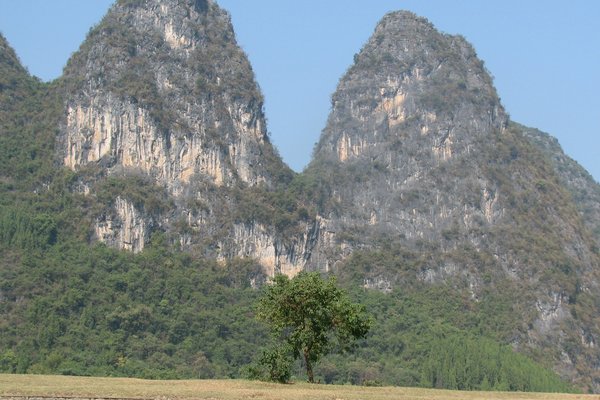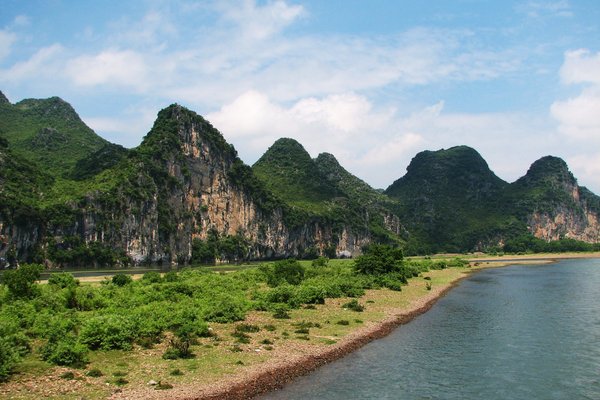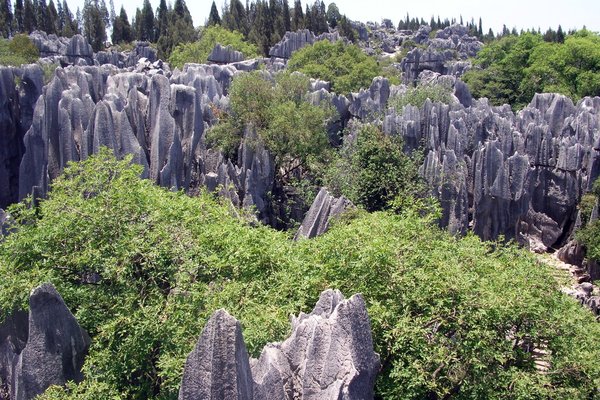China
South China Karst
South China Karst comprises one of the two great karst regions of the world.
This huge karst area represents the variety of karst landforms in the humid (sub)tropics. Shilin is regarded as the world’s best example of pinnacle karst (stone forests), while Libo Karst is renowned for its cone karst and Guilin Karst for its tower karst landscape.
Community Perspective: The 12 components are spread across 4 provinces. Reviews so far have focused on Shilin, the Stone Forest (Solivagant, Els, Frederik) and Guilin Karst with its spectacular scenery along the Li River (Kyle, Nan).
Site Info
Official Information
- Full Name
- South China Karst (ID: 1248)
- Country
- China
- Status
-
Inscribed 2007
Site history
History of South China Karst
- 2014: Extended
- now includes 12 elements spread over the provinces of Guizhou, Guangxi, Yunnan and Chongqing
- 2007: Revision
- Includes former TWHS Lunan Stone Forest Scenic Zone (1996)
- 2007: Inscribed
- Inscribed
- 1992: Rejected
- Bureau - Did not meet WHS criteria (as former TWHS Lunan Stone Forest Scenic Zone)
- Type
- Natural
- Criteria
- vii
- viii
Links
- UNESCO
- whc.unesco.org
- Official
-
- en.chinastoneforest.com — Stone Forest
- Related
-
- uh.edu — A Virtual Field Trip to the Stone Forest
All Links
UNESCO.org
- whc.unesco.org — whc.unesco.org/
Official Website
- en.chinastoneforest.com — Stone Forest
Related Resources
- uh.edu — A Virtual Field Trip to the Stone Forest
News Article
- March 19, 2014 ibtimes.com — Five New Armored Spider Species Discovered In South China Karst Caves
Community Information
- Community Category
- Natural landscape: Karst landscapes and caves
Travel Information
One million visitors or more
Not for Acrophobes
Guangzhou hotspot
Recent Connections
-
Not for Acrophobes
Stone Forests ("The push of people tryi… -
IUGS Geological Heritage Sites
Shilin Karst & Guilin KarstSee iugs-geo…
-
Extended
2014: now includes 12 elements spread o…
Connections of South China Karst
- Trivia
-
-
On Passports
Chinese passport: Yunan -> Shilin Stone Forest -
One million visitors or more
Guilin Lijiang River Karst (2,096,000 visitors in 2012)
-
- Ecology
-
-
Significant Karst Features
These three areas provide typesites for their principal karst features (AB ev) -
Rainforests
Temperate Rainforest
-
- World Heritage Process
-
-
Extended from original TWHS
Originally Lunan Stone Forest Scenic Zone. A serial proposal followed a rejection of the original nomination in 1992. -
Extended
2014: now includes 12 elements spread over the provinces of Guizhou, Guangxi, Yunnan and Chongqing -
Rejected, and then inscribed
Rejected 1992 as former TWHS Lunan Stone Forest Scenic Zone -
Already inscribed still on T List
As 2 separate TWHS: The Lijiang River Scenic Zone at Guilin, and Jinfushan Scenic Spot
-
- Religion and Belief
-
-
Legends and Folk Myths
the girl Ashima that turned into a stoneSee en.wikipedia.org
-
- Human Activity
-
-
Natural sites with indigenous human population
Minority peoples, including the Yi (Shilin) and the Shui, Yao and Buyi (Libo), comprise the majority of residents in two of the nominated areas (AB ev)
-
- Constructions
-
-
Glass floored Skywalks
The glass-floored Wulong Tianshengsanqiao viewing platform within the Three Natural Bridges section of the Wulong Karst -
Suspended cable cars
Cable car at Jinfoshan component
-
- WHS on Other Lists
-
-
World Biosphere Reserves
Includes Maolan (1996) -
Global Geoparks
Shilin Geopark -
IUGS Geological Heritage Sites
Shilin Karst & Guilin Karst
-
- Timeline
-
-
Triassic
The nominated property contains a cross-section of key features of the regional geology of the area including the deposition of carbonates up to the Triassic period (250 million years ago) and the subsequent tectonic evolution of the area (AB ev)
-
- WHS Hotspots
-
-
Guangzhou hotspot
Guilin - just 2.5 hours from Guangzhou (but worth more than a day trip).
-
- Visiting conditions
-
-
Not for Acrophobes
Stone Forests ("The push of people trying to reach the highest vantage points, often quite precipitously located")
-
- Literature & Film
-
-
Star Wars
The limestone karst mountains around Guilin were depicted as Kashyyyk, the Wookie planet shown in “Revenge Of The Sith.” It was the first time that a “Star Wars” movie had been filmed in Asia.
-
News
- ibtimes.com 03/19/2014
- Five New Armored Spider Species Di…
Recent Visitors
Visitors of South China Karst
- Alejandro Lau
- Alexander Barabanov
- Alexander Lehmann
- Alex Goh
- Alex Marcean
- alicemears
- Ammon Watkins
- Ana Lozano
- Anna Wludarska
- Antonio J.
- Artur Anuszewski
- Aspasia
- Atila Ege
- Bamse
- basementonline
- Bill Maurmann
- Bin
- Boj
- Bram de Bruin
- c82wc1
- Carl Le Boeuf
- Carlo Sarion
- Chantal den Haan
- chenboada
- christof
- Christravelblog
- Claire Bradshaw
- Colossus
- cwthong
- Daniela Hohmann
- David Marton
- DavidS
- Deffra
- DL
- Dwight Zehuan Xiao
- Elisabeth Fransisca Situmorang
- Els Slots
- Erfe91
- Erik Jelinek
- Fan Yibo
- Frederik Dawson
- Geert Luiken
- Harald T.
- henryjiao18
- heywhatever2
- Iain Jackson
- Ingrid
- Jacob Otten
- Jan Zimmermann
- Jarek Pokrzywnicki
- Javier Coro
- jballard650
- Jeffrey Chai
- Jens
- J_neveryes
- John Smaranda
- Jonas Kremer
- Jon Eshuijs
- JoStof
- Joyce van Soest
- jxrocky
- Kasper
- KeithBailey
- Kevin McFarland
- Knut
- Kyle Magnuson
- Lameduck99
- Liamps91
- lichia
- Ludvan
- Luis Filipe Gaspar
- Lukasz Palczewski
- Luke LOU
- Maciej Gil
- Malgorzata Kopczynska
- Marcobrey
- Mariam
- Matthewsharris
- MaYumin
- MichaelH
- Mihai Dascalu
- Miloš Tašković
- Morodhi
- Naim Y
- nan
- Niall Sclater
- Nicolas
- Nicole Lampos
- Nihal Ege
- PabloNorte
- Patrik
- Patrik_globe
- Pchxiao
- Petteri
- Pieter Dijkshoorn
- Pink Bunny
- Piotr Wasil
- Qin Xie
- Ralf Regele
- Remski
- Reza
- Rick Ohm
- Risson
- Roman Bruehwiler
- Sergio Arjona
- Shijie ZHU
- Sijia
- Simonf
- SnakeGreen
- Solivagant
- Ssong.x
- Stanislaw Warwas
- Stijn
- Szucs Tamas
- Tamara Ratz
- Taotao Chen
- Tcchang0825
- Thomas Buechler
- Thomas van der Walt
- Tim Allen
- Timonator
- Timothy C Easton
- Tingying He
- tony0001
- trekkie900
- Twobaconsandaboston
- Vincent Cheung
- voyager
- Westwards
- Xander Huang
- Xiong Wei
- Xiquinho Silva
- Yang Chengyu
- Yongcheng Liu
- Zoë Sheng
- Zos M
Community Reviews
Show full reviews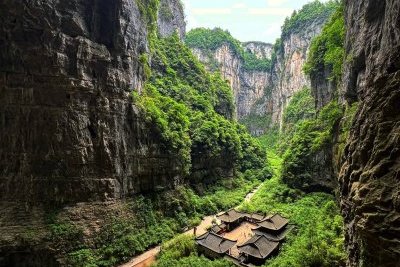
Almost exactly 14 years after I visited Shilin near Kunming, one of the most famous parts of this World Heritage Site, I had a chance to visit Wulong Karst and got a glimpse of Jinfoshan Karst during my trip to Chongqing. For Wulong Karst I only saw 2 of its components, the Three Natural Bridges and Furong Cave. Like Wulingyuan that tourism industry people prefer to call it Zhangjiajie, Wulong Karst is known as Xiannvshan or Fairies Mountains after the nearby booming tourist town that full of fake European especially Italian architectural style bungalows. From the big pyramid shaped tourist center there are frequent bus services to the Three Natural Bridges, the most well known and most visited part of Wulong.
The bus took us to the entrance and then we used the glass elevator down to the below canyon or Chinese called it Tianlong Tiankeng or “Heavenly Dragon Pit”. From the elevator exit we saw the first natural bridge, Tianlong Qiao or "Heavenly Dragon Bridge". The bridge is amazing with its big size probably the biggest natural bridge I have seen, in my opinion this place should be called the natural tunnel. We needed to hike down under the arch to reach the pit, along the way is the famous viewpoint of Chinese pavilion inside the towering karst pit, the one in Transformers: Age of Extinction! When we reached the pavilion which is a historic rest area since ancient times but heavily refurbished to use in many …
Keep reading 0 comments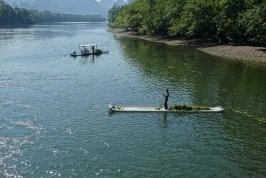
Following my visit to Danxiashan I ventured to Guilin to see the famous Li river section of the South China Karst. Already in Guilin itself you see plenty of rocks rising up and driving to the embarkment of my cruise I noticed even more. The scenery is spectacular and well worth the visit.
On my way back to Guilin we also travelled along the mountains, but this time on the other side. And this is where the site's shortcomings become clear. This isn't a huge fenced off National Park, but a scenic stretch along the river. On the other side of the mountains you are back in civilization with cars, highways and plenty of concrete buildings.
Getting There
I visited the Li river (Li Jiang / 漓江) part of the site from Guilin by cruise. Guilin is a less than 3h trip from Guangzhou South. See my comments on the Guangzhou train station in the China Danxia post.
The Li river cruises leave only in the morning; there are no noon or afternoon cruises. Which is a pity as you won't get the sunrise or sunset shot of the scenery.
It's next to impossible to get to Guilin from Guangzhou in time for the pickup (before 8 a.m.). So I stayed overnight in Guilin with the added benefit that hotels are way cheaper in Guilin than in Guangzhou (140 CNY vs 340 CNY).
In Guilin the train station for nearly all bullet trains is …
Keep reading 0 comments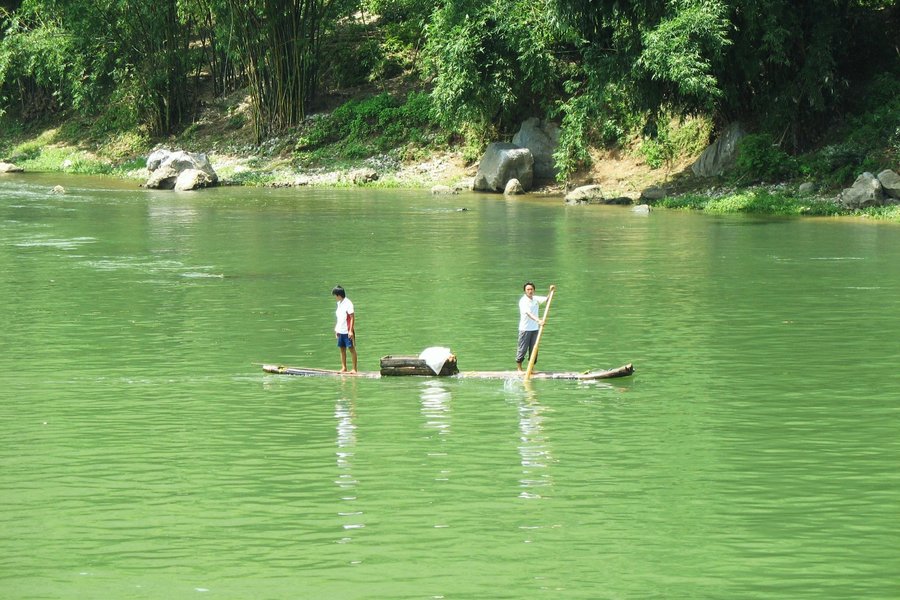
The South China Karst is a wonder to behold. During my time in Guangxi province in 2006 the skies were blue, there was often a pleasant breeze, and the Li River was stunningly picturesque.
After Beijing & Xi'an, Guangxi province was a welcome change of climate. The landscape is vivid green, the karst formations are as varied as the names & legends associated with them. The Nine Horse Mural Hill being one of the "highlights" that will be pointed out to you.
It is only recently, in 2014, that I learned of the "Phase II" expansion nomination of this unique WHS. Therefore, 8 years after my visit to Guilin, this special landscape is now included in the South China Karst WHS. While, I would love to visit other components of this worthy WHS, I am content with visiting the Guilin Karst.
Like numerous others, I took the ferry down the Li River from Guilin to Yangshuo. Moreover, I visited several Karst caves in the area. Yet, it escapes me which ones (if any) are included in the nominated property. Back in 2006, there were few foreign tourists, yet Guilin is very famous within China. In the last decade or so, there is a growing awareness of this site outside the country. Indeed, there will be plenty of tourists, you only have to look at the back of 20 RMB bill to confirm this particular karst landscapes iconic status domestically. The Li River has inspired artists and poets for centuries. I …
Keep reading 0 comments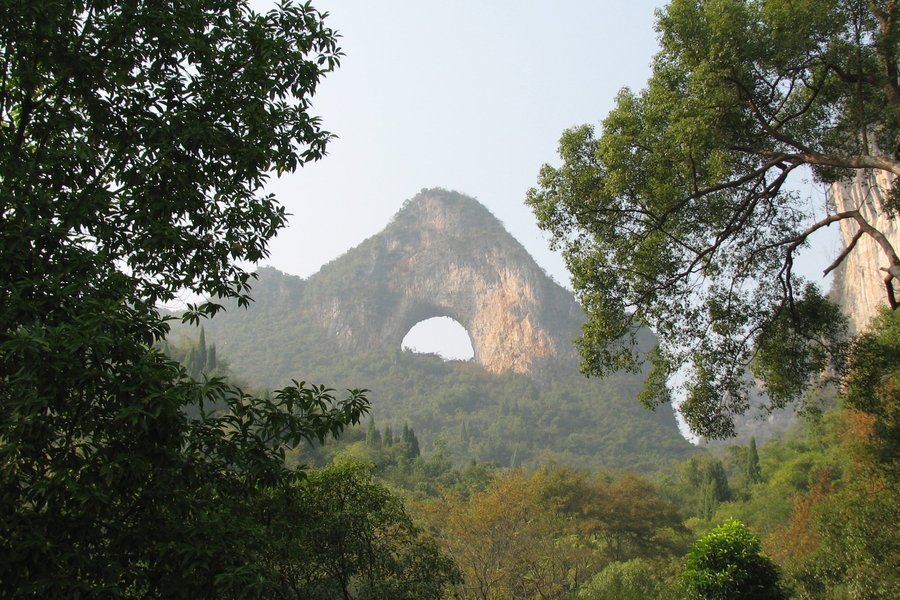
I travelled to stone forest near Kunming in 1985 while backpacking through China with a friend. We found every street corner, every town, every moment to be fascinating. At that time there were few other travellers and we explored the forest by ourselves. I still have a colourful embroidered bag that I bought from a gracious woman. It reminds me of China, a mysterious, beautiful country and my amazing memories. I hope to return one day!
Keep reading 0 comments
Yunnan, the land of Southern Cloud well known for its beautiful natural wonders and unique local culture of many tribes, was chosen by my Chinese Language Club for this year field trip. After wonderful experience from my last year Shanxi trip, I decided to join this program immediately and back to China again.
From all natural wonders of Yunnan, Shilin or Stone Forest, a part of South China Karst, seemed to be the most famous tourist attraction, located not far from Kunming, the capital and gateway of Yunnan, by superhighway in just 1.30 hours. Shilin was a fantasy land of complex bizarre gigantic stones in the beautiful well designed stylish park. With the hefty entrance fee of 175 Yuan, as of 2010, Shilin was still full with Chinese tourists who came to see their "national scenic area".
I was quite surprised to discover that Shilin was located next to the modern city of the same name and had asphalt road rounded Shilin to serve tourists for utmost convenient. However, the paths inside Shilin were really confusing and small, under the shadow of the rocks; all turns showed the different angle of labyrinthine strange stones and pretty ponds. The center point of Shilin was the small Chinese pavilion built on the top of one rock for view grazing; the view was quite nice and made me understand where the idea of stone decoration in Chinese garden came from.
Even though this was not my first time to see karsts or stone …
Keep reading 0 comments
I was born in Kunming,so the Stone Forest is always our pride,each time my friends coming from other provinces or other countries ,i will show them the area.
Last year,I have been in England for almost one year,so i can look at the Stone Forest at different angle.
nowaways,i know very clear that we have to protect our world very carefully.
Keep reading 0 comments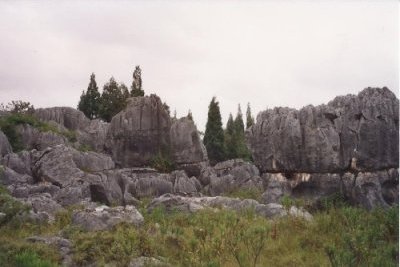
During my trip to Yunnan Province in 1994, I visited the Stone Forest (Shilin) which is close to Kunming. Already at that moment in time, before the Chinese tourist boom, Shilin was a popular getaway for many. What I remember is that many of the 'stone trees' had been given inspirational names (like Two Tortoise Stone or Sword Peak Pond), associations with more meaning to the Chinese than the western mind.
In November 2007, I spent a few days in Yangshuo along the river Li near Guilin. This is a very touristy area, and so much different in atmosphere from the rest of China. I navigated the Li River in a small boat, the most relaxing way to see this landscape. The next day I biked to Moon Hill, to enjoy some different views of the area.
Keep reading 0 comments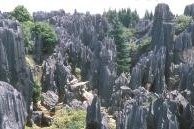
With the inscription of “S China Karst” in 2007 the WHS list contained at least 12 (??) examples of Karst scenery (eroded limestone/dolorite). Since around 12% of continental land worldwide is Karst that might not be so surprising, especially as such landscapes can be extremely interesting and attractive. Enormous areas of Southern China are Karst and, in my mind at least, such scenery is also very “Chinese” in atmosphere because of its use in Chinese painting and garden design. So perhaps it is not unreasonable for yet another Karst site to be inscribed - but which of the many possible examples should China have chosen?
Surprisingly, it hasn’t selected the most famous and, in my view the best, example – the scenery around Guilin/Yangshuo, but decided to go with a “serial” proposal of widely spread locations in Yunnan, Guizhou and around Chongqing as a “Phase 1” with Yangshuo and many others to follow in future phases. Coincidentally (???) another site inscribed on the same day at Christchurch in 2007, the Atsinanana Forest in Madagascar, adopted exactly the same approach of serial, physically unconnected sites in what is intended to be a multi phase inscription linked by an overarching “theme”. Has there been some policy guidance from above or have countries seen that this gives them several “bites at the cherry” in getting at least one site inscribed?
Indeed the evaluation of both proposals followed a similar trajectory with a few areas being jettisoned along the way as a “sacrifice” on …
Keep reading 0 comments
